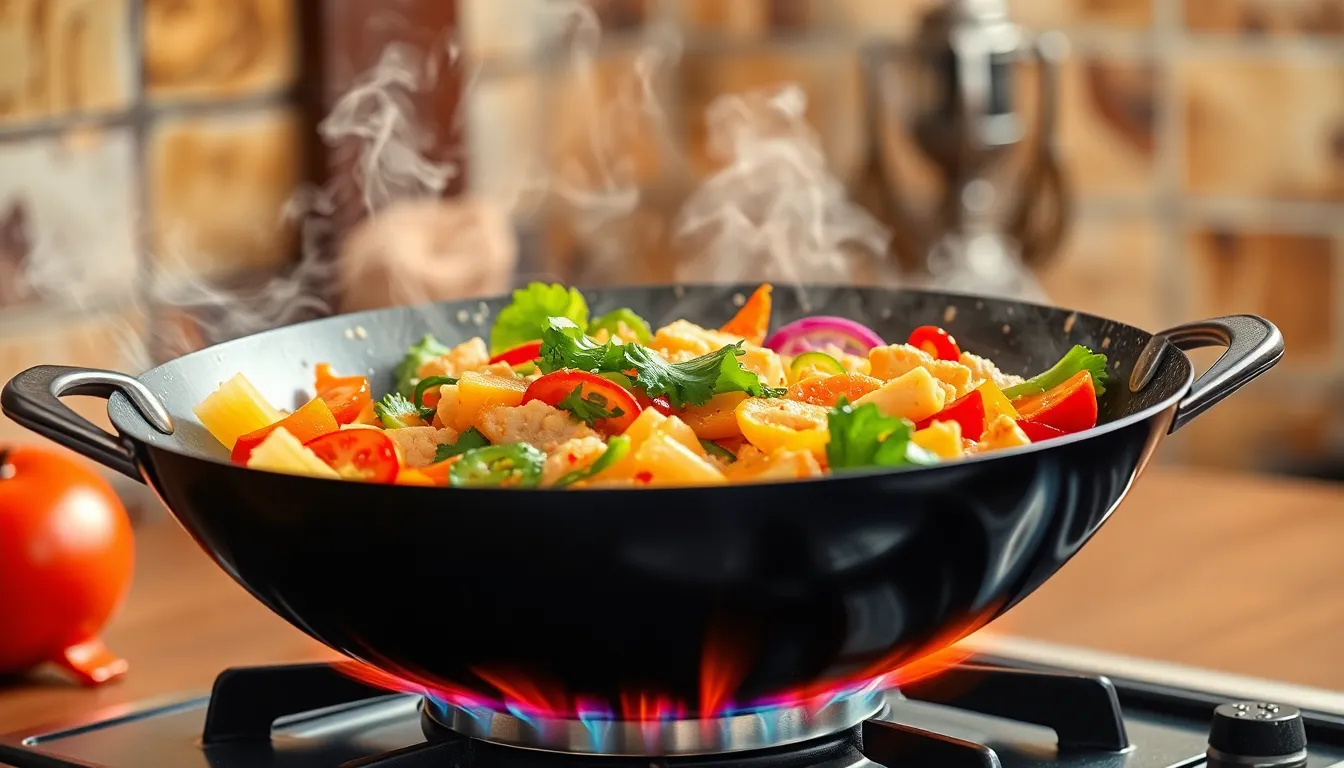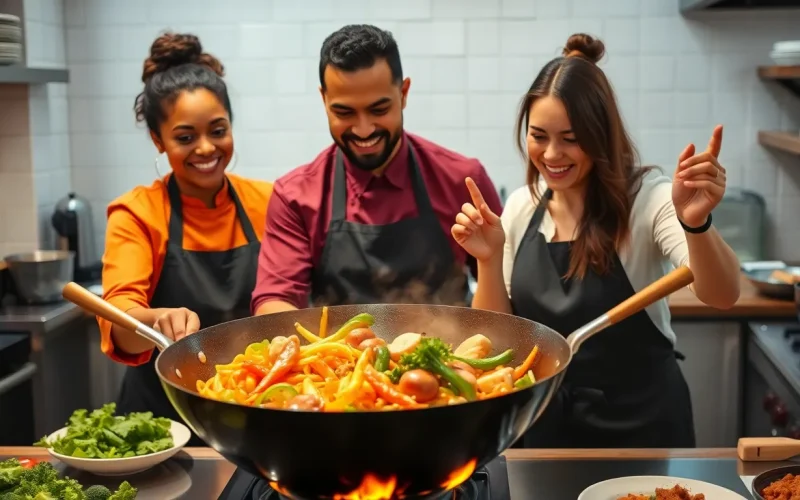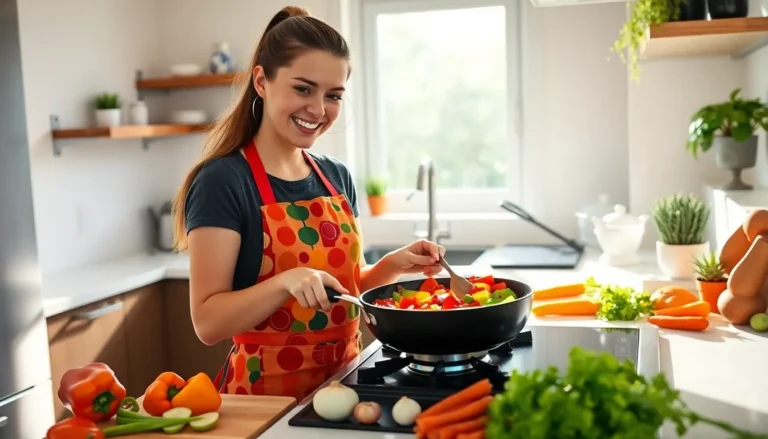Table of Contents
ToggleWhen it comes to culinary adventures, few cuisines are as rich and diverse as Chinese cooking. From the sizzling woks to the delicate dumplings, mastering Chinese techniques can turn any kitchen into a bustling street market in Beijing. Whether you’re a novice or a seasoned chef, these methods can elevate your dishes from ordinary to extraordinary faster than you can say “Kung Pao chicken.”
Overview of Chinese Cooking Techniques
Chinese cooking techniques encompass a variety of methods that chefs use to create flavorful dishes. Stir-frying stands out as one of the most popular techniques, involving quick cooking over high heat with a small amount of oil. This method retains the texture and color of vegetables while infusing them with rich flavors.
Another essential technique, steaming, preserves nutrients, making it a healthy choice for cooking proteins and vegetables. Often used for dumplings and fish, steaming enhances the natural taste of ingredients without added fats.
Braised cooking combines both dry and wet heat in a single process. Foods sautéed briefly develop a rich color, while simmering liquid adds depth to the dish. This technique works well for tougher cuts of meat, transforming them into tender, flavorful meals.
Deep-frying, in contrast, creates a crisp outer layer, sealing in moisture and flavor. Popular in dishes like sweet and sour pork, this method requires careful temperature control to avoid greasy results.
Roasting, another valuable technique, imparts smokiness and unique flavors. This method encompasses various dishes, from Peking duck to char siu.
Lastly, the art of balancing flavors plays a vital role in Chinese cooking. Chefs consider the five basic tastes—sweet, sour, bitter, spicy, and salty—while preparing a dish. Harmonizing these flavors enhances overall enjoyment and satisfaction.
Understanding these techniques paves the way for enhancing culinary skills. Mastering these methods enables any cook to create authentic Chinese cuisine that reflects the rich traditions and diverse flavors of the culture.
Stir-Frying

Stir-frying is a fundamental Chinese cooking technique known for its speed and flavor retention. This method emphasizes high heat and quick cooking, creating vibrant dishes that showcase fresh ingredients.
Equipment Used for Stir-Frying
Woks are essential for stir-frying, featuring a rounded bottom that distributes heat evenly. They allow for swift cooking and easy tossing of ingredients. A sturdy spatula, often made of wood or metal, helps to move food around the wok efficiently. Gas burners provide the preferred high heat, enabling quick temperature adjustments. Additionally, a splatter guard can prove useful, especially with oil-rich ingredients. Each of these tools enhances the stir-frying process, ensuring a successful culinary experience.
Key Ingredients in Stir-Frying
High-quality proteins like chicken, beef, or tofu serve as the base for many stir-fry dishes. Fresh vegetables such as bell peppers, broccoli, and snap peas add crucial color and nutrition. Aromatics, including garlic and ginger, provide a fragrant foundation for flavor. Soy sauce serves as a primary seasoning, imparting depth and umami. Incorporating sesame oil offers a rich finish to the dish. Rice or noodles often accompany stir-fries, rounding out the meal with texture and substance. Each ingredient plays a vital role in achieving a harmonious balance in flavors.
Steaming
Steaming stands out as a fundamental technique in Chinese cooking. This method emphasizes health and the preservation of flavors.
Benefits of Steaming
Steaming retains nutrients that other cooking methods can diminish. This technique enhances the natural flavors of ingredients, making them tender without losing moisture. Dishes prepared by steaming often have a light texture, appealing to those seeking healthier options. Diet-conscious individuals appreciate steamed vegetables, which maintain vibrant colors and nutritional benefits. Another advantage includes minimal added fat, fostering a lower calorie count in meals. Chefs frequently use steaming for delicate ingredients like seafood and dumplings, ensuring they remain succulent and flavorful.
Common Steaming Techniques
Bamboo steamers frequently serve as the go-to equipment for steaming in Chinese cuisine. These natural, eco-friendly tools allow for efficient heat circulation. Dropping ingredients into the steamer basket ensures even cooking, while layering preserves flavor intensity. Water in the pot creates steam, heating food gently and evenly. Alternatively, electric steamers offer convenience and consistent results for busy cooks. Cooking times vary depending on ingredient type and size; for instance, dumplings may require 15 minutes, while fish usually finishes within 10. Mastering these steaming techniques elevates culinary skills, yielding satisfying and healthy dishes.
Braising
Braising stands as a cornerstone technique in Chinese cooking that enriches flavors while tenderizing tougher cuts of meat. It leverages both dry and wet heat, leading to delectable, comforting dishes.
Types of Braising
Two main types of braising shine in Chinese cuisine: red braising and white braising. Red braising involves simmering meat in soy sauce, sugar, and spices, producing a rich, savory flavor. This method often includes ingredients like star anise and ginger, enhancing complexity. White braising, on the other hand, relies on clear broth with fewer spices, allowing the natural taste of the ingredients to emerge. Both techniques cater to various meats. Chefs typically use beef, pork, or chicken for red braising, while fish and poultry control flavor through white braising, each resulting in distinct textures and aromas.
Flavor Development in Braising
Flavor depth in braising arises from a slow cooking process that melds ingredients harmoniously. Initially, searing meat creates a caramelized layer that adds richness. After adding liquid and aromatics, heat melds flavors over an extended period, usually one to three hours. Variations in ingredients, such as mushrooms or herbs, contribute additional taste profiles. Chefs often adjust seasoning at the end, ensuring a balanced final dish. The resulting sauce embodies a complex fusion. Mastery of this technique offers cooks the ability to produce robust dishes that embody the essence of Chinese culinary traditions.
Roasting
Roasting holds a significant place in Chinese cuisine, often imparting rich flavors and a satisfying texture to various ingredients. This technique boasts a variety of traditional methods that enhance both taste and presentation.
Traditional Roasting Methods
Traditional Chinese roasting methods include techniques like Beijing-style roasting and spit-roasting. Beijing roast duck stands out as a classic, featuring a specially crafted oven that ensures crispy skin and succulent meat. Spit-roasting, involving slow cooking over an open flame, allows for even heat distribution, promoting tenderness. Charcoal roasting, often used for meats, infuses a smoky flavor, captivating the palate. These methods prioritize a balance of heat and time, resulting in dishes that are both flavorful and visually appealing.
Popular Roasted Dishes
Popular roasted dishes showcase the versatility of this cooking technique. Peking duck, notable for its crispy skin and tender meat, entices with its rich flavor. Another favorite, soy sauce chicken, results in a savory, glossy exterior paired with juicy meat. Roasted pork belly, featuring a crackling top layer, offers a satisfying crunch alongside tender layers. These dishes reflect the cultural significance of roasting, celebrating the blend of flavors and aromas that define Chinese culinary heritage.
Exploring Chinese cooking techniques opens doors to a world of flavor and creativity. Each method brings its unique attributes to the table, enhancing the culinary experience. Whether it’s the quick precision of stir-frying or the gentle embrace of steaming, these techniques allow cooks to elevate their dishes significantly.
By mastering braising and roasting, individuals can create meals that resonate with tradition and authenticity. The journey through Chinese cuisine is not just about preparing food; it’s about embracing a rich cultural heritage. With practice and passion, anyone can transform their cooking skills and delight in the vibrant tastes of Chinese dishes.





